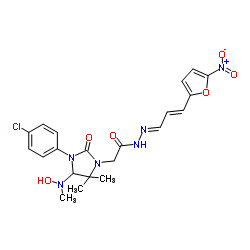Eeyarestatin I is a novel and potent ERAD (endoplasmic reticulum-associated protein degradation) inhibitor and protein translocation inhibitor with anticancer activity. Acting to induce tumor cell death and disturb ER homeostasis by blocking membrane-bound p97.
Physicochemical Properties
| Molecular Formula | C27H25CL2N7O7 |
| Molecular Weight | 630.436103582382 |
| Exact Mass | 490.136 |
| CAS # | 412960-54-4 |
| Appearance | Yellow to orange solid powder |
| Density | 1.4±0.1 g/cm3 |
| Index of Refraction | 1.643 |
| LogP | 3.63 |
| InChi Key | JTUXTPWYZXWOIB-UHFFFAOYSA-N |
| InChi Code | InChI=1S/C27H25Cl2N7O7/c1-27(2)24(35(40)25(38)31-19-9-5-17(28)6-10-19)34(20-11-7-18(29)8-12-20)26(39)33(27)16-22(37)32-30-15-3-4-21-13-14-23(43-21)36(41)42/h3-15,24,40H,16H2,1-2H3,(H,31,38)(H,32,37) |
| Chemical Name | 2-[3-(4-chlorophenyl)-4-[(4-chlorophenyl)carbamoyl-hydroxyamino]-5,5-dimethyl-2-oxoimidazolidin-1-yl]-N-[3-(5-nitrofuran-2-yl)prop-2-enylideneamino]acetamide |
| Synonyms | Eeyarestatin I |
| HS Tariff Code | 2934.99.9001 |
| Storage |
Powder-20°C 3 years 4°C 2 years In solvent -80°C 6 months -20°C 1 month Note: Please store this product in a sealed and protected environment, avoid exposure to moisture. |
| Shipping Condition | Room temperature (This product is stable at ambient temperature for a few days during ordinary shipping and time spent in Customs) |
Biological Activity
| Targets | Endoplasmic reticulum-associated protein degradation (ERAD) |
| ln Vitro | A549 and H358 cells treated with eeyarestatin I (2.5–40 μM; 48 hours) experience quantitative essential cell death [1]. Treatment of A549 and H358 cells with eeyarestatin I (2.5–40 μM; 48 hours) resulted in a rise in endoplasmic reticulum (ER) intermediate markers, including Bip and CHOP at as low as 20 μM. Important proteins, such as IRE1α and PERK, are ubiquitinated in a dose-dependent manner when treated with eeyarestatin I[1]. Treatment with eeyarestatin I (20 μM; 48 hours; A549 and H358 cells) causes cell invasion and migration [1]. By most likely deactivating the Sec61 complex, eeyarestatin 1 inhibits the transfer of immature proteins from membrane complexes to the ER translocation machinery [2]. Assay for viability [1] |
| Cell Assay |
Viability assay [1] Cell Types: A549 and H358 cells Tested Concentrations: 2.5 μM, 5 μM, 10 μM, 20 μM, 40 μM Incubation Duration: 48 hrs (hours) Experimental Results: Caused dose-dependent cell death of A549 and H358 cells. Western Blot Analysis[1] Cell Types: A549 and H358 Cell Tested Concentrations: 2.5 μM, 5 μM, 10 μM, 20 μM, 40 μM Incubation Duration: 48 hrs (hours) Experimental Results: Increased ER stress markers including Bip and CHOP. |
| References |
[1]. Regulation of VCP/p97 demonstrates the critical balance between cell death and epithelial-mesenchymal transition (EMT) downstream of ER stress. Oncotarget. 2015 Jul 10;6(19):17725-37. [2]. Eeyarestatin I inhibits Sec61-mediated protein translocation at the endoplasmic reticulum. J Cell Sci. 2009 Dec 1;122(Pt 23):4393-400. [3]. Inhibition of p97-dependent protein degradation by Eeyarestatin I. J Biol Chem. 2008 Mar 21;283(12):7445-54. [4]. ERAD inhibitors integrate ER stress with an epigenetic mechanism to activate BH3-only protein NOXA in cancer cells. Proc Natl Acad Sci U S A. 2009 Feb 17;106(7):2200-5. [5]. Inhibitors of the Sec61 Complex and Novel High Throughput Screening Strategies to Target the Protein Translocation Pathway. Int J Mol Sci. 2021 Nov 5;22(21):12007. |
Solubility Data
| Solubility (In Vitro) |
DMSO: 25~85 mg/mL (39.7~134.8 mM) Ethanol: ~7 mg/mL (~11.1 mM) |
| Solubility (In Vivo) |
Solubility in Formulation 1: 1.25 mg/mL (1.98 mM) in 10% DMSO + 40% PEG300 +5% Tween-80 + 45% Saline (add these co-solvents sequentially from left to right, and one by one), suspension solution; with sonication. For example, if 1 mL of working solution is to be prepared, you can add 100 μL of 12.5 mg/mL clear DMSO stock solution to 400 μL PEG300 and mix evenly; then add 50 μL Tween-80 + to the above solution and mix evenly; then add 450 μL normal saline to adjust the volume to 1 mL. Preparation of saline: Dissolve 0.9 g of sodium chloride in 100 mL ddH₂ O to obtain a clear solution. (Please use freshly prepared in vivo formulations for optimal results.) |
| Preparing Stock Solutions | 1 mg | 5 mg | 10 mg | |
| 1 mM | 1.5862 mL | 7.9310 mL | 15.8619 mL | |
| 5 mM | 0.3172 mL | 1.5862 mL | 3.1724 mL | |
| 10 mM | 0.1586 mL | 0.7931 mL | 1.5862 mL |
